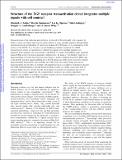Structure of the EGF receptor transactivation circuit integrates with cell context
Author(s)
Joslin, Elizabeth J.; Shankaran, Harish; Opresko, Lee K.; Bollinger, Nikki; Lauffenburger, Douglas A.; Wiley, H. Steven; ... Show more Show less
DownloadJoslin Molec BioSyst 2010.pdf (1.717Mb)
PUBLISHER_POLICY
Publisher Policy
Article is made available in accordance with the publisher's policy and may be subject to US copyright law. Please refer to the publisher's site for terms of use.
Terms of use
Metadata
Show full item recordAbstract
Transactivation of the epidermal growth factor receptor (EGFR) is thought to be a process by which a variety of cellular inputs can be integrated into a single signaling pathway through either stimulated proteolysis (shedding) of membrane-anchored EGFR ligands or by modification of the activity of the EGFR. As a first step towards building a predictive model of the EGFR transactivation circuit, we quantitatively defined how signals from multiple agonists were integrated both upstream and downstream of the EGFR to regulate extracellular signal regulated kinase (ERK) activity in human mammary epithelial cells. By using a “non-binding” reporter of ligand shedding, we found that transactivation triggers a positive feedback loop from ERK back to the EGFR such that ligand shedding drives EGFR-stimulated ERK that in turn drives further ligand shedding. Importantly, activated Ras and ERK levels were nearly linear functions of ligand shedding and the effect of multiple, sub-saturating inputs was additive. Simulations showed that ERK-mediated feedback through ligand shedding resulted in a stable steady-state level of activated ERK, but also showed that the extracellular environment can modulate the level of feedback. Our results suggest that the transactivation circuit acts as a context-dependent integrator and amplifier of multiple extracellular signals and that signal integration can effectively occur at multiple points in the EGFR pathway.
Date issued
2010-05Department
Massachusetts Institute of Technology. Department of Biological EngineeringJournal
Molecular BioSystems
Publisher
Royal Society of Chemistry
Citation
Joslin, Elizabeth J. et al. “Structure of the EGF receptor transactivation circuit integrates multiple signals with cell context.” Molecular BioSystems 6.7 (2010): 1293.© 2010 Royal Society of Chemistry.
Version: Final published version
ISSN
1742-206X
1742-2051